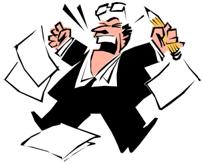Triggers
 Is there something that can set you off – a word, a gesture, a sound, a sight, a smell? These are referred to as stimuli or triggers because they stimulate or trigger a reaction.
Is there something that can set you off – a word, a gesture, a sound, a sight, a smell? These are referred to as stimuli or triggers because they stimulate or trigger a reaction.
We’ve all fired off our triggers at the most inappropriate times, most often without any pre-thought; they just went off.
I wish I could tell you I had a foolproof way of that never happening again. I don’t. If it’s valuable to you, I do know a way to get them to fire less, so we don’t shoot off our mouths or shoot ourselves in the foot as often.
Oftentimes, we don’t know the trigger to our behavior. We could spend a lot of time looking for it or spend lots of money with a therapist to help us find it. The problem with that approach is that some behaviors have multiple triggers, and trying to find them all would take longer than a lifetime.
The more triggers a pattern of behavior has; the less likely you are to find them all, and it’s more likely that pattern will stay in place. For example, there are thousands of triggers for eating and some appeal to each of the senses: Sight smell, hearing, taste and touch. For some, the smell of bread baking can trigger the desire to eat a whole loaf. They weren’t born with that trigger, it was conditioned.
So if we can’t consciously find all the triggers, how do we get a trigger guard on them all?
Here is a technique that I use when I conduct a Smoking Cessation or Weight Loss seminar: I guide people into a more relaxed frame of mind and offer them a “one-size-fits-all” suggestion. The suggestion is this: “Whatever those things are that triggered you to (fill in the behavior) in the past, those very same things begin now to trigger feelings of being calm and collected. And when you’re calm and collected, you make much better choices.”
Your subconscious knows all the triggers because the subconscious is where all the reactions to them are stored. When you non-specifically address them all (“whatever those things are”), your subconscious knows exactly what you are referring to. The next suggestion, “those very same things begin now to trigger feelings of being calm and collected,” throws a switch in your mind to have a different reaction to those triggers – to be calm and collected. The final suggestion, “and when you are calm and collected, you make much better choices,” alerts your mind not only to all the better choices, but to the fact that you have a choice.
I am forever grateful to Dr. Dave Dobson for teaching me this technique which he called a “Subjective Reversal.” The subject (or trigger) reversed the automatic response and opened us up to choice.
It’s a powerful exercise, but it’s only powerful if you use it.
Think of the behavior you would like to change; just don’t burden yourself with trying to find out why it happens. Then offer yourself the suggestion “That whatever those things are that triggered this behavior in the past, those very same things begin now to trigger feelings of being calm and collected.” Then use any mind quieting method you know to enter the “Cauldron of Change” known as a quiet mind.
Like all developed skills it takes a bit of practice. Each time you do it, you apply mental calamine lotion to an itchy trigger finger.
All the best,
John
JOHN MORGAN COACHING
ACCOMPLISH ANYTHING
LOSE WEIGHT & KEEP IT OFF
STOP SMOKING FOREVER
SLEEP THROUGH THE NIGHT EVERY NIGHT
IMPROVE YOUR SELF CONFIDENCE
I LOVE MY BODY
RELAX IN 2 MINUTES
FEEL FOREVER YOUNG
VIRTUAL MASSAGE
Be Sociable, Share!

